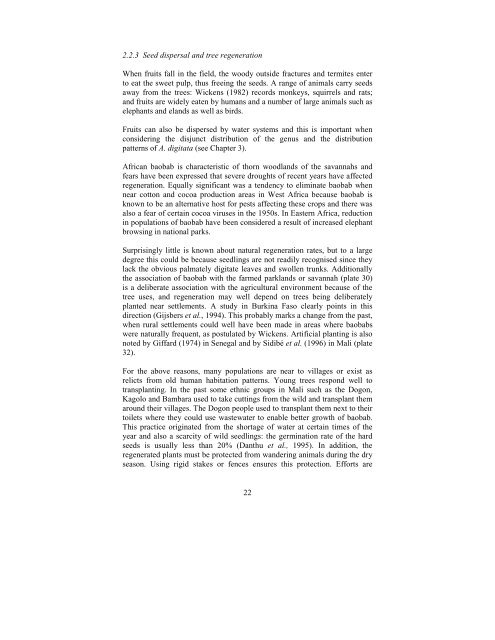Baobab Monograph.pdf - Crops for the Future
Baobab Monograph.pdf - Crops for the Future
Baobab Monograph.pdf - Crops for the Future
Create successful ePaper yourself
Turn your PDF publications into a flip-book with our unique Google optimized e-Paper software.
2.2.3 Seed dispersal and tree regeneration<br />
When fruits fall in <strong>the</strong> field, <strong>the</strong> woody outside fractures and termites enter<br />
to eat <strong>the</strong> sweet pulp, thus freeing <strong>the</strong> seeds. A range of animals carry seeds<br />
away from <strong>the</strong> trees: Wickens (1982) records monkeys, squirrels and rats;<br />
and fruits are widely eaten by humans and a number of large animals such as<br />
elephants and elands as well as birds.<br />
Fruits can also be dispersed by water systems and this is important when<br />
considering <strong>the</strong> disjunct distribution of <strong>the</strong> genus and <strong>the</strong> distribution<br />
patterns of A. digitata (see Chapter 3).<br />
African baobab is characteristic of thorn woodlands of <strong>the</strong> savannahs and<br />
fears have been expressed that severe droughts of recent years have affected<br />
regeneration. Equally significant was a tendency to eliminate baobab when<br />
near cotton and cocoa production areas in West Africa because baobab is<br />
known to be an alternative host <strong>for</strong> pests affecting <strong>the</strong>se crops and <strong>the</strong>re was<br />
also a fear of certain cocoa viruses in <strong>the</strong> 1950s. In Eastern Africa, reduction<br />
in populations of baobab have been considered a result of increased elephant<br />
browsing in national parks.<br />
Surprisingly little is known about natural regeneration rates, but to a large<br />
degree this could be because seedlings are not readily recognised since <strong>the</strong>y<br />
lack <strong>the</strong> obvious palmately digitate leaves and swollen trunks. Additionally<br />
<strong>the</strong> association of baobab with <strong>the</strong> farmed parklands or savannah (plate 30)<br />
is a deliberate association with <strong>the</strong> agricultural environment because of <strong>the</strong><br />
tree uses, and regeneration may well depend on trees being deliberately<br />
planted near settlements. A study in Burkina Faso clearly points in this<br />
direction (Gijsbers et al., 1994). This probably marks a change from <strong>the</strong> past,<br />
when rural settlements could well have been made in areas where baobabs<br />
were naturally frequent, as postulated by Wickens. Artificial planting is also<br />
noted by Giffard (1974) in Senegal and by Sidibé et al. (1996) in Mali (plate<br />
32).<br />
For <strong>the</strong> above reasons, many populations are near to villages or exist as<br />
relicts from old human habitation patterns. Young trees respond well to<br />
transplanting. In <strong>the</strong> past some ethnic groups in Mali such as <strong>the</strong> Dogon,<br />
Kagolo and Bambara used to take cuttings from <strong>the</strong> wild and transplant <strong>the</strong>m<br />
around <strong>the</strong>ir villages. The Dogon people used to transplant <strong>the</strong>m next to <strong>the</strong>ir<br />
toilets where <strong>the</strong>y could use wastewater to enable better growth of baobab.<br />
This practice originated from <strong>the</strong> shortage of water at certain times of <strong>the</strong><br />
year and also a scarcity of wild seedlings: <strong>the</strong> germination rate of <strong>the</strong> hard<br />
seeds is usually less than 20% (Danthu et al., 1995). In addition, <strong>the</strong><br />
regenerated plants must be protected from wandering animals during <strong>the</strong> dry<br />
season. Using rigid stakes or fences ensures this protection. Ef<strong>for</strong>ts are<br />
22

















